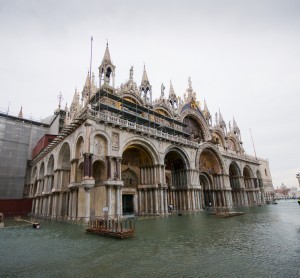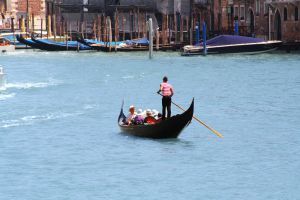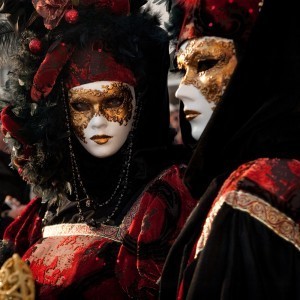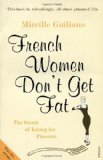Hannah Fielding's Blog, page 114
December 24, 2013
The fragility of Venetian beauty
 Venice is known internationally as a beautiful and romantic city, not least for its lagoon location, countless waterways and, of course, the age-old gondolas on which lovers drift dreamily amid the buildings. But the dark side to this watery ambiance is that nature is not a force that one can control, and thus now and again man and his creations and the surging ocean do battle.
Venice is known internationally as a beautiful and romantic city, not least for its lagoon location, countless waterways and, of course, the age-old gondolas on which lovers drift dreamily amid the buildings. But the dark side to this watery ambiance is that nature is not a force that one can control, and thus now and again man and his creations and the surging ocean do battle.
Floods, sadly, are no new occurrence in Venice. They are the price Venetians pay for having settled so close to the Adriatic. Back in 1966, for example, the lagoon level rose 6.5 feet above its usual level, as a result of high tides and strong winds, and many historic palaces and piazzas were underwater. Homes were destroyed, as were priceless artworks.
The recent floods in Venice, caused by heavy rain and strong winds, haven’t reached the severity of 1966 disaster, but they covered 95 per cent of the historic city centre with waters reaching 1.5 metres in depth – too deep to even wade through safely. Businesses, schooling, tourism: all ground to a halt as Venetians waited impatiently for the sea to reclaim its overspill.
According to recent research, not only are global warming and rising silt levels causing the lagoon levels to rise, but the effect of the floods is that Venice is sinking and tilting to the east, heading out to the Adriatic Sea. Floods are growing more common – and residents are becoming used to walking on wooden planks to stay above the floodwaters some four or five times each year.
The Venetians are investing heavily in a flood defence system. But in the meantime, ‘The Floating City’ is coming a little too close for comfort to living up to its name. The result: this historic, elegant, visually stunning city to which lovers worldwide flock for the ambiance is infused with an air of fragility, of the threat of impermanence, of becoming the modern-day Atlanta.
Do the precarious foundations make Venice any less of a city of love, of beauty, of mystique? Not at all – if anything, I think the city is all the more precious for its watery predicament. I just hope that in the future readers of my Venetian-set novel The Echoes of Loveare transported to a vibrant, real place they can aspire to visit, and not to a lost city that has become little more than a memory on the pages of books.
December 23, 2013
Mark Twain’s take on the gondola
 Have you read The Innocents Abroad? It depicts famous American writer Mark Twain’s journey through Europe and the Holy Land, with startlingly crisp detail, Twain’s trademark twang of irreverent humour and some poignant philosophising, such as, ‘Human nature appears to be just the same, all over the world.’ In fact, it was his bestselling book in his lifetime, and it remains one of the most bought travel books in history.
Have you read The Innocents Abroad? It depicts famous American writer Mark Twain’s journey through Europe and the Holy Land, with startlingly crisp detail, Twain’s trademark twang of irreverent humour and some poignant philosophising, such as, ‘Human nature appears to be just the same, all over the world.’ In fact, it was his bestselling book in his lifetime, and it remains one of the most bought travel books in history.
Venice was one stop on Twain’s trip, and in Chapter 23 he gives a wonderful description of the gondola which is as relevant today as it was then, in 1869, when the book was first published. It’s a superb piece of literature, I’m sure you’ll agree.
The Venetian gondola is as free and graceful, in its gliding movement, as a serpent. It is twenty or thirty feet long, and is narrow and deep, like a canoe; its sharp bow and stern sweep upward from the water like the horns of a crescent with the abruptness of the curve slightly modified.
The bow is ornamented with a steel comb with a battle-ax attachment which threatens to cut passing boats in two occasionally, but never does. The gondola is painted black because in the zenith of Venetian magnificence the gondolas became too gorgeous altogether, and the Senate decreed that all such display must cease, and a solemn, unembellished black be substituted. If the truth were known, it would doubtless appear that rich plebeians grew too prominent in their affectation of patrician show on the Grand Canal, and required a wholesome snubbing. Reverence for the hallowed Past and its traditions keeps the dismal fashion in force now that the compulsion exists no longer. So let it remain. It is the color of mourning. Venice mourns. The stern of the boat is decked over and the gondolier stands there. He uses a single oar–a long blade, of course, for he stands nearly erect. A wooden peg, a foot and a half high, with two slight crooks or curves in one side of it and one in the other, projects above the starboard gunwale. Against that peg the gondolier takes a purchase with his oar, changing it at intervals to the other side of the peg or dropping it into another of the crooks, as the steering of the craft may demand–and how in the world he can back and fill, shoot straight ahead, or flirt suddenly around a corner, and make the oar stay in those insignificant notches, is a problem to me and a never diminishing matter of interest. I am afraid I study the gondolier’s marvelous skill more than I do the sculptured palaces we glide among. He cuts a corner so closely, now and then, or misses another gondola by such an imperceptible hair-breadth that I feel myself “scrooching,” as the children say, just as one does when a buggy wheel grazes his elbow. But he makes all his calculations with the nicest precision, and goes darting in and out among a Broadway confusion of busy craft with the easy confidence of the educated hackman. He never makes a mistake.
December 22, 2013
‘Que C’est Triste Venise’ (How Sad Venice Can Be)
Are you familiar with the classic song ‘Que C’est Triste Venise’ by French-Armenian singer Charles Aznavour? It was a big hit internationally in the 1960s, translated from the original French to English, German and – most successfully – Italian. I love the song, and I listened to it often while writing my novel The Echoes of Love. It sparks such a sense of romantic nostalgia in me. Following are the French and Italian versions, and an English translation (source).
The original French version
The later Italian version (‘Com’è Triste Venezia’)
The lyrics
How sad Venice can be when you return alone
To find a memory in every paving stone
I walk among the birds that fill San Marco’s Square
With echoes of her words around me in the air.
How sad Venice can be when the mandolins play
A song she sung for me, one unforgotten day
Like images of sleep, the gondoliers go by
But when I try to weep, I find my tears are dry.
How sad Venice can be when mist is in your eyes
And you can hardly see, as pigeons fill the skies
I find the little street and then the old café
Where we would always meet to dream away the day.
How sad Venice can be, beneath the silent moon
That rises from the sea and silvers the lagoon
I hear the vespers chime and cross the Bridge of Sighs
I know that it is time to bid my last goodbyes.
There’s nothing more to say, I pass beneath the light
And then I turn away from Venice in the night
How sad Venice can be, it’s too lonely to bear
When you have lost the love that you discovered there.
December 21, 2013
Move over mince pies, gingerbread, stollen and cookies, and make way for panettone
 This season I’m ‘in an Italian mood’ thanks to the December publication of my new novel, The Echoes of Love, which is set in Venice, Tuscany and Sardinia. So what better Christmas treat to share than the staple Italian seasonal cake: panettone.
This season I’m ‘in an Italian mood’ thanks to the December publication of my new novel, The Echoes of Love, which is set in Venice, Tuscany and Sardinia. So what better Christmas treat to share than the staple Italian seasonal cake: panettone.
Panettone, in case you haven’t tried it, is a light, fluffy, sweet bread traditionally eaten over Christmas and New Year in Italy (and abroad – many people love the taste and texture). It usually has a quintessential ‘cupola’ shape, but sometimes you find star-shaped panettone. Traditional additions to the bread are orange and lemon zest, and raisins – and chocolate chips are popular internationally. It’s usually served with a hot drink such as coffee or hot chocolate (for a sumptuous recipe, see here), or a liqueur like amaretto.
The sweet bread dates back to Roman times, when it was made with honey, but the modern version was first created in Milan. The origin of the name ‘panettone’ is somewhat up for debate:
It comes from the Italian word panetto, meaning a small loaf cake (adding ‘one’ at the end charges the meaning to large, so ‘the small large loaf cake’!).
It means ‘bread of Toni’ (pan de Toni) and is named for either Toni, the daughter of a poor baker, or Toni, a kitchen boy who invented the cake, or a Friar Toni, whose ecclesiastical hat inspired the shape.
It comes from the Milanese phrase pan del ton, which translates to ‘cake of luxury’.
Panettone isn’t an easy Christmas delicacy to make at home (though if you’re up for the challenge, you may find this article useful: ‘How to make the perfect panettone’). So you may be best checking out the options at your local gourmet food outlet or deli (imported from Italy will taste best). The coffee chain Café Nero serves a variety too.
Here are some recipes that offer inventive ways to use the panettone in other dishes – well, if you haven’t eaten it all for afternoon tea, that is!
Layered panettone and ricotta pudding (Antonio Carluccio)
Italian Christmas pudding cake (Nigella Lawson)
Steamed panettone pudding with hot punch sauce (Delia Smith)
Summer panettone cake (Jamie Oliver)
Panettone break and butter pudding (Jamie Oliver)
Coffee and maple panettone (Lorraine Pascale)
Enjoy!
December 20, 2013
Book review: A Christmas Hope by Anne Perry
From the blurb:
A Christmas Hope is… the gripping story of an unforgettable battle between goodness and evil in Victorian London—and a lonely woman’s search for meaning in her life.
Claudine Burroughs, a volunteer in Hester Monk’s clinic for sick and injured prostitutes, no longer expects closeness with her coldly ambitious husband and dreads the holidays. Then, at a glittering yuletide gala, she meets the attractive poet Dai Tregarron and suddenly her spirits lift. Alas, an hour later, this fascinating man is enmeshed in a nightmare—accused of killing a young streetwalker who had been smuggled into the party.
Even though she suspects that an upper-class clique is quickly closing ranks to protect the real killer, Claudine and the clinic’s disreputable bookkeeper, Squeaky Robinson, vow to do their utmost for Dai. But it seems that hypocritical London society would rather send an innocent poet to the gallows than expose the shocking truth about one of their own.
Nevertheless, it’s the season of miracles and Claudine and Squeaky finally see a glimmer of hope—not only for Dai but for an innocent young woman teetering on the brink of a lifetime of unhappiness. Anne Perry’s heartwarming new holiday novel is a celebration of courage, faith, and love for all seasons.
In the lead-up to Christmas, I decided to review some seasonal books this year, and I chose this one easily from the selection on NetGalley because I love the setting and the era in which it is set, and the cover drew me in.
I found this to be a jolly (forgive the pun) good read. It’s not overtly ‘a Christmas book’, but in fact one you could read at any time of year; but the themes of redemption and compassion sit very well at this time of year. I found myself, as I read, thinking a little of books like Dickens’ A Christmas Carol for the setting and morals coming forth – a wonderful way to get into the festive spirit.
The heroine, Claudine, is eminently likable – but romantic that I am, I yearned for some resolution to her unhappy marriage (at one point, I half-convinced myself she could walk off into the sunset with Dai, but the more I read of his womanising and drinking, the more I had to let go of that!). She’s feisty and wonderfully courageous for the era, and I love her tenacity in sticking to her principles and ensuring that justice is done.
For me, though, the standout character is Squeaky Robinson (such a fabulous name!), who is from a very different class to Claudine but is indisputably a good man. Together with Claudine’s work at the clinic with women of ill repute, Squeaky’s character really grounds the book, so that it’s not one-dimensional, following Society ladies and gents around, but is rooted in the reality of the times.
I very much liked what I saw of the character of Dai as well – particularly his poetic dialogue at the beginning, and I’d have liked to have seen more of him. Perhaps in another book?
Overall, a well-paced, interesting read that keeps you on your toes throughout and leaves you with that ‘all’s right in the world’ feeling at the end – a great addition to your festive ‘to read’ list.
I was offered this book in exchange for a fair review via NetGalley.
A Christmas Hope is available now from Amazon; click on the book cover below to visit the store.
December 19, 2013
The sun through the trees
December 18, 2013
Authors and social media: Striking the balance
 Ten years ago, being an author was, in a sense, fairly straightforward. You wrote a book. You attempted to sell that book to agents/publishers. If successful, you took part in some limited marketing activities (a radio interview, say, and writing an article for the press), but for the most part you happily got on with writing your next novel.
Ten years ago, being an author was, in a sense, fairly straightforward. You wrote a book. You attempted to sell that book to agents/publishers. If successful, you took part in some limited marketing activities (a radio interview, say, and writing an article for the press), but for the most part you happily got on with writing your next novel.
Today, the landscape for authors is radically different. You write a book. You attempt to sell that book to agents/publishers, or you sell it directly to readers via self-publishing. And you take part in myriad marketing activities, offline and – crucially – online via social media: blogging, Goodreads, Facebook, Twitter; the list is seemingly endless. And although you yearn to happily get on with writing your next novel, you find yourself somewhat torn between being a marketeer and a novelist.
The key question today, then, for any author is this: How much time should I dedicate to writing, and how much time to marketing?
Certainly, there is no definitive answer, and each author must strive to strike the balance that best works for them and for their writing and publishing projects. Personally, I believe the key is to have discipline and organise yourself effectively to do both – then you are always on top of the business of being an author. But remember always that your dream is to write, and ensure that the writing itself is the weightier portion of your daily, weekly, monthly efforts.
‘What impact has social media made on your writing in recent years?’ is a question recently posed by Mslexia, ‘the magazine for women who write’. The findings of their survey offer a good insight into how writers feel about social media, and how much of a role and impact it has on their lives.
60% blog; 75% Facebook and 55% Tweet – but 8% have never used any form of social media.
Over half spend one to five hours each week on social media, but 2% admitted to spending more than thirty hours!
On the positive side, some respondents found social media great for publicising work, finding opportunities and building connections. But a dark side was also exposed in the findings, with issues such as privacy, addictiveness and cyber bullying coming forth, plus a sizeable proportion (43%) felt social media is a distraction from writing.
While I’m well versed with the limitations and drawbacks of social media (how much easier it is to chat on Twitter or write a blog post than push through a challenging chapter of writing), I’m certainly of the opinion that social media is an excellent tool for authors. Let me draw you back to the opening of this post:
Ten years ago, being an author was fairly straightforward. You wrote a book. You attempted to sell that book to agents/publishers.
Today, you write a book. You attempt to sell that book to agents/publishers, or you sell it directly to readers via self-publishing.
The key difference? It comes down to that word ‘sell’. Ten years ago, authors were relatively powerless in the selling process. But today… Social media gives the author leverage, a kind of power. An agent is more likely to be interested in your book if you’ve already built a sizeable Twitter following, for example; and you’re far more likely to sell well directly to the reader if you’re already connecting with them online.
Well, that’s my take on the subject, and now, having spent some time writing this blog post, it’s time to close WordPress and go back to the novel. The modern-day author: juggler extraordinaire.
December 16, 2013
The best hot chocolate in Venice
 My new book, The Echoes of Love, opens with a rescue: enigmatic stranger Paolo saves the heroine, Venetia, from a near-mugging. In the aftermath of the incident, with the attacker having fled and Venetia decidedly shaken, there is only one way forward as far as the commanding and kind Paolo is concerned:
My new book, The Echoes of Love, opens with a rescue: enigmatic stranger Paolo saves the heroine, Venetia, from a near-mugging. In the aftermath of the incident, with the attacker having fled and Venetia decidedly shaken, there is only one way forward as far as the commanding and kind Paolo is concerned:
‘You’re shivering. You’ve had a bad shock and you need a warm drink. Come. There’s a caffeteria that serves the best hot chocolate in Venice, just a few steps from here. It’ll do you good.’ Without waiting for a response, he took Venetia’s arm and led the way down the narrow street.
I could, of course, have chosen an alcoholic beverage as the means by which to calm a trembling soul – brandy, perhaps – or alternatively sweet tea. But the joy of being a writer is creating a world just as you like it, and for me the ideal hero understands the restorative powers of chocolate for a woman!
Because I live for part of the year in France, hot chocolate is no rare treat for me. After all, many French people take a cup of chocolat chaud with breakfast. The Italians, too, embrace the hot chocolate and pastry tradition of their neighbours, the French, and when I visited Venice while researching The Echoes of Love, I tasted for myself ‘the best hot chocolate in Venice’. A single sip and all is right in the world!
With winter now well and truly settling in, ’tis the season for hot chocolate. All the major coffee chains are marketing their specialties: I had a particularly nice mint hot chocolate recently. But for a soothing, warming, set-the-world-to-rights hot chocolate you need not head to your local coffee house: this is a drink that’s easy to make at home.
Here is my favourite and very easy homemade hot chocolate recipe to serve one, depending on your appetite, with some ideas for flavourful twists. No instant powder mixes in sight!
Ingredients
60g chopped high-quality chocolate (I love Green and Blacks; try different varieties, including white!)
1 cup milk, warmed but not to boiling point
Dash of water
1. Melt the chocolate in the water, in a glass bowl over a simmering pan of water, stirring continuously.
2. Meanwhile, warm the milk to your desired temperature, taking care not to boil it.
3. Add the chocolate to the milk and stir thoroughly.
Flavourings: liqueurs (Amaretto is divine), vanilla essence, cinnamon, nutmeg, mint syrup or a peppermint stick, orange syrup or zest, chilli powder (yes, really!), espresso for a mocha, caramel sauce, coconut milk, maple syrup.
Toppings: whipped cream; marshmallows cocoa powder; chocolate curls; chocolate, toffee or butterscotch drizzle; a scoop of ice-cream (hot chocolate must be very hot) – or a little of all!
And if you’re having a moment of guilt about indulging in such a pure pleasure, can I recommend the following book to you? It’s a compelling read on ‘the secret of eating for pleasure’ that opens the door to eating the very best foods and drinking the very best drinks while remaining healthy and happy.
December 14, 2013
The masks of the Venice Carnival
 What is more romantic, more mysterious, more alluring, more dangerous than a masquerade?
What is more romantic, more mysterious, more alluring, more dangerous than a masquerade?
Last week I wrote about the Commedia dell’arte, a 16th-century Italian dramatic form that originated in Venice in which masked actors improvise in stock roles to entertain the audience. The masks are a vital and universally recognisable feature of the Commedia, and so too are they inherent in the tradition of the Venice Carnival – an event that features in the opening of my new romance novel, The Echoes of Love.
Venetian masks date back to the parties Venetians held during the 13th century at which they would wear beautiful masks to conceal their identities, so allowing both upper and lower classes to mingle freely and live out their fantasies (plenty of debauchery would follow, from gambling to affairs).
In today’s Carnival, party-goers and revellers in the street parades wear traditional Venetia masks of two kinds – those of the Commedia dell’arte, and specific Carnival ones. Well-known Carnival masks include:
The Bauta, which is always white and covers the whole face, and is often worn with a tricorno hat.
The black velvet Moretta, worn by women and traditionally held in place by gripping a protrusion with the teeth, thus rendering the woman silent!
The Columbina, an eye mask that became very popular (after all, revellers want to be able to eat and drink easily!)
This website has some great pictures of these masks, and this site gives a fabulous overview of the main mask types worn.
The tradition of the Carnival mask dates back hundreds of years. Notable features include:
Vibrant colours
Extravagance, as visible in the fine adornments
Individuality – each mask is unique
Artistry – these are very much works of art
Wide ranging materials: gold leaf, fur, lace, sequins, precious fabrics, feathers, gems, beads, metallic objects, papers… the list is endless
Some masks are made from porcelain – these are the most expensive masks, and are often used as wall décor now rather than for wearing. Others are made from leather – a true artisan’s mask; when my heroine Venetia first sees Paolo in The Echoes of Love during a Carnival party she is drawn to his eyes ‘behind the devilish features of his half-face leather black mask’. But more typically, masks are made from a kind of papier mâché, allowing the mask artists complete control in crafting the contours. The papier mâché is applied to a mold made from plaster or clay and lubricated with Vaseline, and then baked in an oven until dry. Then eye holes are cut, and the artist sands, varnishes, paints and decorates the mask.
For some wonderful examples of masks – and if you feel like indulging yourself in an authentic Venetian mask for your next masquerade event – take a look at these website: Mask Italia, Venetian Mask Shop, 1001 Venetian Masks and Dream of Italy.










